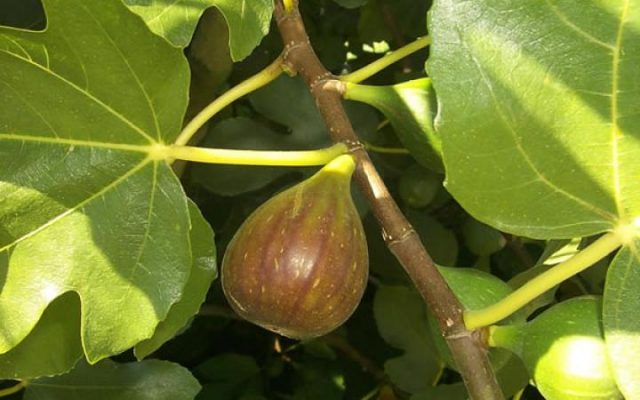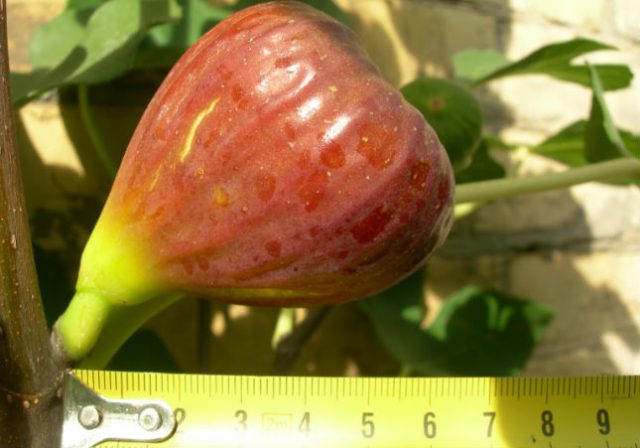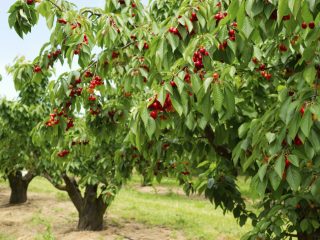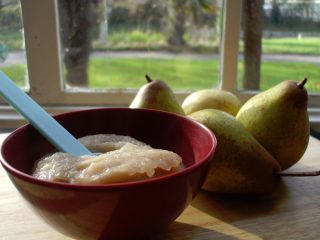Content
Fig Brunswik has been known for a long time. One of the most frost-resistant varieties spread across the southern regions of the country among gardeners. Enthusiasts also grow figs in the middle lane, providing a reliable special shelter or transferring them into a voluminous tub, which stands in an impermeable room.
Description of figs Brunswick
In the subtropics, the tree grows over 2 m, the flat-rounded crown is created by spreading branches. The roots of the figs are the same branched, sometimes more than 10 m in diameter and 5-7 m deep. In the Russian climate, even in the south, Brunswik figs are not allowed such a height, they regularly cut off the branches, and when planting, they take care of preventing the distant spread of the roots. The leaves differ sharply from any known culture: they are very large, up to 20-25 cm, with deeply cut blades. The top is dense and rough, the bottom is fleecy and soft. The flowers of the female type are also unusual, inconspicuous, located inside the future fruit formation, which grows in the form of an irregular, elongated ball.
An early self-fertile Brunswick fig gives 2 full harvests when there is sufficient heat:
- in the middle of summer;
- at the beginning of autumn.
The Brunswick variety matures in 2.5-3 months. The fruits reach the degree of technical ripeness 25-60 days after harvest.
In the middle of summer, the first wave of ripe Brunswick figs is rather scarce. The fruits are large, with a flat top, 5x7 cm in size, weighing up to 100 g and more. The skin color is often purple. There is a large cavity in the pink juicy pulp. The taste is sweet and pleasant. Autumn fruits of irregular pear-shaped figs, small - 5x4 cm, do not exceed 70 g, may not ripen in the climate of the middle zone due to the early onset of frost. Thin, fleecy skin is light green; in the sun it acquires a yellow-brown blush. In the fruits of the second harvest, the delicate flesh is reddish brown, high in sugars and a small cavity. The seeds are small and common.
Frost resistance of Brunswick figs
According to the description, when grown outdoors, Brunswick figs can withstand temperatures down to -27 ° C in a sheltered state. Nevertheless, in the reviews, many gardeners indicate that prolonged low temperatures below -20 ° C lead to the freezing of the plant. The Brunswik variety has the ability to recover after a harsh winter, to start up new shoots from the root system preserved under cover. The main task of the gardener is to keep the roots from freezing. This is achieved by specific concealment methods. The culture is grown in greenhouses or indoor conditions, planted in tubs in those zones of plant frost resistance, where the maximum minus indicators fall below the level of 18-12 ° C.
Pros and cons of Brunswick figs
The fruits of this southern culture are so excellent in taste that gardeners dream of new breeding achievements. Perhaps, somewhere they are already working on the breeding of more frost-resistant varieties of figs. For most gardeners in the middle lane, the unreality of wintering a plant in open ground is the only drawback of the Brunswik variety.Although it is still the most cold-resistant of its kind.
Advantages of the Brunswick variety:
- figs are adapted for growing in climates where freezing temperatures briefly drop to -20 ° C in winter;
- high productivity;
- excellent taste;
- self-fertility;
- early maturity;
- the possibility of collecting sweet fruits twice a day.
Fig growing Brunswick
The Brunswik repair fig with light green fruits is planted taking into account the specific care requirements of the southern crop.
Selection and preparation of the landing site
Figs are unpretentious to soils: they can grow well on sandy, loamy, clayey and calcareous. But the taste of the fruit depends on the amount of minerals in the planting pit and on the site. The high acidity of the soil is not suitable for the culture. One of the important requirements for successful fig cultivation is a sufficient amount of moisture and, at the same time, good soil drainage. In the middle lane for the Brunswik variety, it is better to dig a trench in advance along with a hole where the plant is laid for winter shelter. For the planting substrate, the garden soil is mixed with an equal part of humus or compost and half of the sand is added. The landing site should only be on the south side, protected by buildings from the north.
Perlite is added to the tubs to the substrate, in addition, a drainage layer is arranged. Indoor plants of the variety are transplanted after 2-3 years, constantly cutting off the roots during transshipment.
Landing rules
When planting the Brunswik variety, they fulfill the requirements:
- the planting pit should be 2 times the volume of the container from the nursery;
- when planting figs, the stem is arranged in the soil deeper than it grew in the container;
- near the trunk, retreating 20-30 cm, they hammer the support;
- straighten the roots, sprinkle with the remaining substrate, simultaneously compacting it several times;
- pour 10 liters of water, moisten again with this amount every other day and mulch the hole.
Watering and feeding
Brunswick figs are irrigated moderately, given the age of the plant:
- in the first 2-3 years, watered after 7 days on a bucket on a tree;
- adult specimens - every 2 weeks, 10-12 liters;
- in the phase of ripeness of fruits, watering is not carried out;
- the last watering is applied after harvesting the fruits in September.
The culture is fed after 15 days:
- in the spring, nitrogen preparations are used;
- during flowering - complex, with phosphorus;
- potash compositions are introduced in the phase of ovary enlargement.
It is convenient to carry out foliar dressing with ready-made balanced products. Organic is a good fertilizer for figs. A prerequisite for dressing is application with watering for better absorption of nutrients.
Pruning
In figs Brunswick, judging by the description of the variety and photos, in the southern regions they form a sprawling cup-shaped crown, with a stem height of 40-60 cm.In the middle lane there is a two-meter bush, which is easier to bend to the ground for shelter in winter. In the spring, shoots thickening the crown are removed. Fan pruning is also practiced, when all branches that grow vertically are cut from a three-year-old seedling. The lower shoots are bent with the help of improvised means after the tree has been watered. Branches older than 5 years are cut in the fall at ground level, because they no longer bend over when covered. New shoots of the Brunswick variety come into fruiting after a year.
Preparing for winter
In the gardens of the middle climatic zone, Brunswik fig vines formed by a bush are bent down and buried in pre-prepared trenches. The branches are bent gradually, starting from the day the last fruits were removed. In regions with mild winters, the whole tree is wrapped after the onset of frost. The trunk circle is mulched with sawdust, peat or spruce branches. In Crimea, the Brunswik variety is grown without winter shelter.
Harvesting
In figs of this variety, the fruits first ripen in the first decade of July, the second harvest in September. Autumn fruiting lasts about a month. Ripe fruits are removed, then green ones for ripening. Consumed fresh, for preservation and drying.
Diseases and pests
Figs are threatened by the fungal disease Fusarium, from which the roots and the lower part of the trunk first suffer. Then the plant dies. Affected specimens are removed from the site. On culture, aphids, moths, flies parasitize, which destroy leaves, damage fruits, and carry pathogens of fungal and viral diseases. Prevent the reproduction of pests and the spread of diseases by autumn harvesting of foliage and spraying on the kidneys with copper-containing preparations, treatment with fungicides, insecticides.
Reviews about figs Brunswick
Conclusion
Fig Brunswik, the most frost-resistant variety of the species, is cultivated by many keen gardeners. Before purchasing a seedling, they carefully study the specifics of growing an exotic plant. Creating the right conditions will make it possible to enjoy the legendary fruits.













